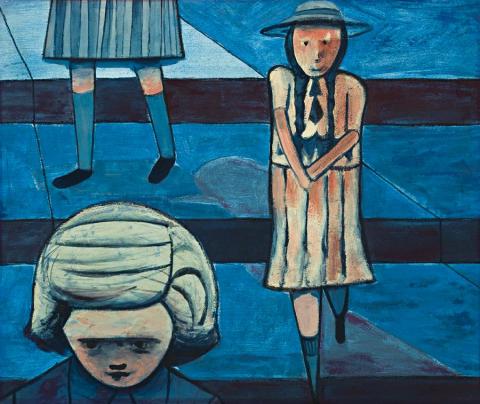THE STAIRS, 1952
CHARLES BLACKMAN
oil and tempera on pulpboard
63.5 x 76.0 cm
signed and dated upper right: B. March. 52
inscribed verso: The Stairs
Mr Egon Grossberg, Melbourne
Gould Galleries, Melbourne
Savill Galleries, Sydney
Private collection, Sydney
Savill Galleries, Melbourne
Private collection, Sydney
Private collection, Melbourne
Bonhams and Goodman, Melbourne, 25 August 2009, lot 46
Private collection, Sydney
Treasures Revealed: Modern Australian Art, Gould Galleries, 1–24 September 1995, cat. 32
Australian Paintings, Savill Galleries, Melbourne, 26 February – 28 March 2004, Sydney, 20 March – 3 April 2004, cat. 40
Modern and Contemporary Paintings, Savill Galleries, Melbourne 5 – 17 July 2008, Sydney, 30 July – 16 August 2008
The first truly unique visions to emerge in his painting, Charles Blackman's Schoolgirls were pivotal in establishing his reputation as an artist of immense individuality. Indeed, reviewing his inaugural solo exhibition at Peter Bray Galleries, Melbourne in 1953 - a classic succès de scandale - art critic Alan McCulloch was quick to recognise and applaud the new talent: '...in the hands of merely a competent painter such a subject would be ludicrous. In Blackman's hands however, John Shaw Neilson's schoolgirl becomes a creature of endless aesthetic possibilities. With literally nothing in the way of subject matter to help him, this young artist has created a series of paintings which are at once exciting and extremely stimulating. This then - the degree of inspiration that an artist can wrest from his subject - must surely be the test of an artist's powers.'1
Commenced in 1952 following Blackman's move to Melbourne the previous year, the Schoolgirl series was inspired initially by the reality of the artist's new environment - the neighbourhood of Hawthorn where, travelling to and from his coach-stable studio, uniformed schoolgirls were a daily sight. More profoundly however, the series resonated with his underlying fear of isolation, a fear that was poignantly reawakened by the recent notorious murder of a schoolgirl near the old Melbourne markets.
With their tenderness and lyricism, such images also reveal Blackman's insight into the female psyche - a legacy of vivid childhood memories of his mother and sisters that were revived by his reading of the literature of childhood fantasy, particularly French novels of adolescent eroticism such as the Claudine schoolgirl series by Colette. Interestingly, it was not until well after Blackman had embarked upon the theme that he encountered the John Shaw Neilson schoolgirl poetry to which his work is often compared. Admiring especially the semi-blind poet's emotional use of colour, Blackman found the mystical verse'very akin to what I felt myself in some sort of way... the frailty of their image as such, and their being a kind of receptacle...of very delicate emotional auras.'2
One of Blackman's earliest interpretations of the theme, The Stairs 1952 presents a myriad of emotional states, from vulnerable and self-absorbed to all-knowing, even predatory. More specifically perhaps, the very awkwardness of the act of walking down steps becomes a metaphor of youth - the girl to the right ungainly with her hunched shoulders, yet trying hard to be otherwise, while to the left, the young head is by contrast more mature and purposeful, questioning that which lies ahead. As such, the figures, divided by bands of deep blue, may be understood as symbolising stages of youthful progress - of coming and going, and the emotions that each entails.
1. McCulloch, A., 'Quantity - and Quality', The Herald, 12 May 1953, p. 10
2. Blackman in an interview with Thomas Shapcott, 6 September 1966, cited in St John Moore, F., Charles Blackman: Schoolgirls and Angels, National Gallery of Victoria, Melbourne, 1993, p. 6
VERONICA ANGELATOS
